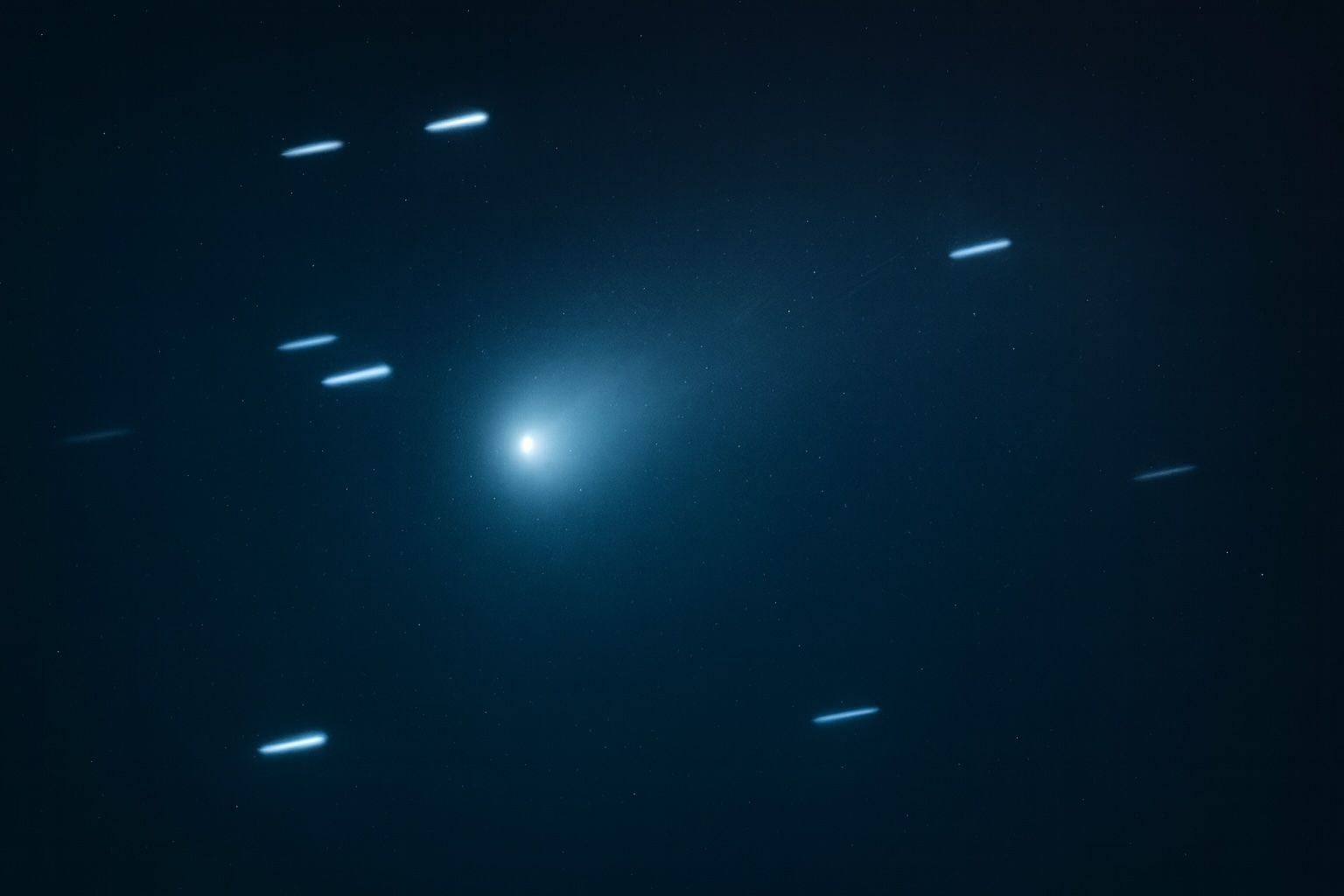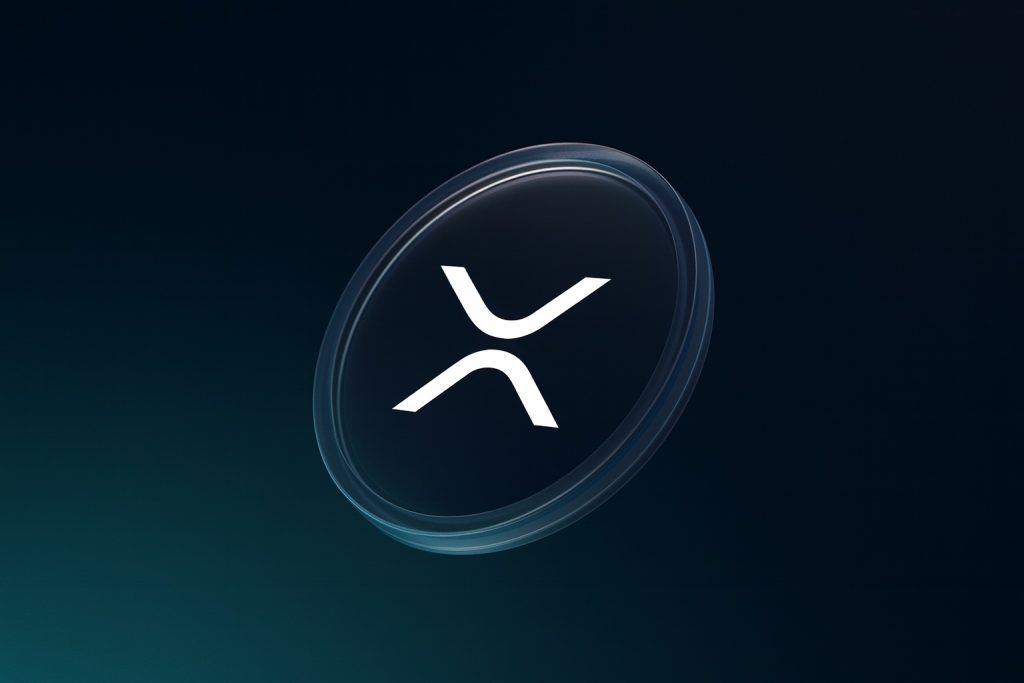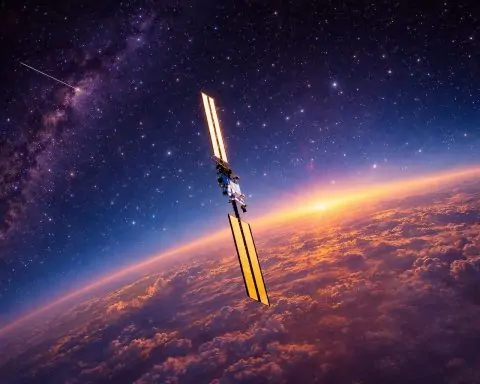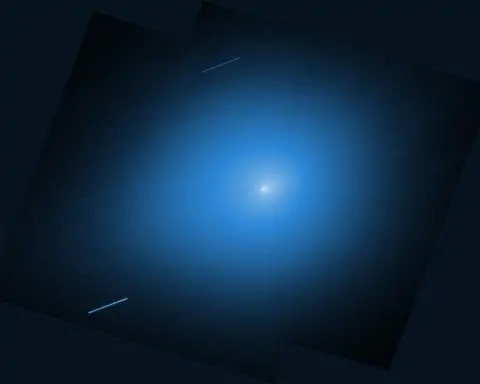- Third interstellar visitor – Discovered on 1 July 2025 by the ATLAS survey, 3I/ATLAS is only the third object observed entering the solar system from interstellar space after ʻOumuamua and 2I/Borisov [1]. Its highly hyperbolic orbit (eccentricity ≈ 6.14) and speed near 210 000 km/h (~137 000 mph) confirm it is unbound to the Sun [2].
- No threat to Earth – The comet will never come closer than ~1.8 AU (270 million km) from Earth [3]. At perihelion on 29–30 October 2025 it will pass ~1.4 AU from the Sun [4], then cross Jupiter’s orbit in March 2026 [5].
- Small but active nucleus – Hubble’s July 2025 images show a teardrop‑shaped coma and restrict the nucleus to between 440 m and 5.6 km in diameter [6] [7]. The comet began outgassing while still beyond Jupiter, producing a dust fan and tail similar to ordinary comets [8].
- Ancient, carbon‑rich composition – Spectroscopy from NASA’s Webb telescope and SPHEREx mission reveals abundant carbon dioxide and water ice but almost no carbon monoxide, with a CO₂/H₂O ratio of about 8:1 [9]. Researchers note this suggests 3I/ATLAS formed in a carbon‑rich protoplanetary disk and may be over 7 billion years old [10] [11].
- Extensive spacecraft campaign – Earth‑based telescopes lost sight of the comet in September as it approached the Sun; Mars orbiters observed it during a 1–7 October fly‑by at 29 million km [12], and ESA’s Jupiter Icy Moons Explorer (JUICE) will monitor it during November when it is brightest [13]. A long list of NASA and ESA missions—including Hubble, Webb, SPHEREx, TESS, Swift, Mars rovers, and Europa Clipper—plan additional observations [14].
- No naked‑eye spectacle – The comet will never be brighter than about magnitude 12, so it requires at least an 8‑inch telescope; the best ground‑based viewing will occur in December when it emerges from behind the Sun [15]. Claims on social media that the object is an alien craft or will collide with Earth have been debunked by NASA and ESA [16].
A Rare Interstellar Visitor
When astronomers with the Asteroid Terrestrial‑impact Last Alert System (ATLAS) noticed an object with an extraordinarily high orbital eccentricity racing through the outer solar system in June 2025, they immediately suspected an interstellar origin. Follow‑up observations confirmed that the body, now designated 3I/ATLAS, follows a hyperbolic path and moves faster than any known comet, approximately 210 000 km per hour [17]. Unlike periodic comets, this object will never return once it leaves the Sun’s gravitational grasp, making it only the third confirmed interstellar visitor after ʻOumuamua in 2017 and 2I/Borisov in 2019 [18].
The comet’s trajectory takes it between the orbits of Mars and Jupiter. NASA’s orbital calculations show that it will safely miss Earth by more than 1.8 AU (270 million km) and reach perihelion—its closest approach to the Sun—around 30 October 2025 at a distance of ~1.4 AU [19]. After skirting the Sun, it will swing past Jupiter in March 2026 and then continue into interstellar space [20]. This assuredly benign flight path has not stopped doomsday rumours; viral posts claiming that 3I/ATLAS is on a collision course or is an alien spacecraft prompted NASA and ESA to release statements noting that the comet “poses no danger” and instead provides an unprecedented scientific opportunity [21].
Size and Structure: A Small Nucleus Wrapped in Dust
Early telescope images suggested the object had developed a puffy, tear‑shaped coma—a cloud of gas and dust released by sublimating ices. Hubble’s crisp pictures taken 21 July 2025 show a sunward dust fan and a faint anti‑solar tail [22]. By modeling the brightness of this halo, astronomers estimate that the solid nucleus is no more than 5.6 km across and could be as small as 440 m [23] [24]. Despite its modest size, the comet sheds 12–120 kg of dust per second according to a preprint analysing Hubble data [25].
What makes 3I/ATLAS unusual is the timing of its activity. Typical long‑period comets remain inert until they approach the orbit of Mars or the asteroid belt, yet this object was already sporting a distinct coma while beyond Jupiter. Astrophysicist Jacqueline McCleary from Northeastern University notes that the comet formed a visible coma early and appeared to emit its own light, which led some on social media to speculate about artificial origins [26]. In reality, the brightness stems from outgassing ices and dust reflecting sunlight.
Chemical Clues to a Distant Birthplace
The most compelling scientific questions concern what the comet’s composition can reveal about planetary systems beyond our own. Observations from the James Webb Space Telescope (JWST) and the SPHEREx mission have detected large amounts of carbon dioxide gas and water ice but found little carbon monoxide [27]. Carey Lisse of the Johns Hopkins Applied Physics Laboratory explains that the unusually high CO₂/H₂O ratio (~8:1) suggests the comet “was well baked and boiled” before being expelled from its home system [28]. Water and CO₂ are common volatiles in comets, but the relative dearth of carbon monoxide hints that 3I/ATLAS formed in a region rich in CO₂ or experienced heating that drove off CO. Some scientists believe the comet originated in the thick disk of the Milky Way and could be over seven billion years old [29] [30]—making it older than our solar system.
McCleary notes that deciphering the chemical fingerprint of 3I/ATLAS will help researchers understand how planetesimals form around other stars. “Studying the composition of this comet gives us a window into conditions in another solar system,” she told Northeastern University News [31]. As the comet nears the Sun, its water ice will vaporise, releasing additional gases and forming a larger coma. NASA’s upcoming SPHEREx infrared survey will map the comet’s emissions in 102 wavelengths, enabling astronomers to separate contributions from CO₂, H₂O, methane, and various organics [32].
A Global Observing Campaign
Because the comet’s motion quickly carried it to the far side of the Sun, Earth‑based observations were largely restricted to July and August. NASA coordinated a multi‑mission campaign involving the Hubble Space Telescope, Webb, TESS, Swift, SPHEREx, and numerous ground observatories [33]. When 3I/ATLAS disappeared into solar glare in September, planetary missions took over.
Mars Encounter
On 3 October 2025 the comet passed within 29 million km (18 million mi) of Mars—the closest approach to any planet. ESA’s Mars Express and ExoMars Trace Gas Orbiter (TGO) aimed their cameras and spectrometers at the passing visitor. Instruments such as OMEGA, SPICAM, and NOMAD measured the spectrum of sunlight reflecting off the coma to identify gases and dust [34]. Although these instruments were not designed to image distant comets, scientists hoped to capture the comet’s long tail and glean clues about its composition [35]. NASA’s Mars Reconnaissance Orbiter and the Perseverance and Curiosity rovers also attempted to photograph the faint fuzzball against the Martian sky.
JUICE and Other Spacecraft
After the Mars encounter, 3I/ATLAS continued inward toward perihelion. ESA’s newly launched Jupiter Icy Moons Explorer (JUICE) prepared to observe the comet from 2–25 November, when it would have a bright halo and long dust tail [36]. JUICE’s wide‑angle cameras and spectrometers will monitor the evolving coma as the comet warms, complementing earlier data from Hubble and Webb. Other missions scheduled to watch include NASA’s Europa Clipper, Lucy, and Psyche spacecraft as well as the Juno probe when the comet later crosses Jupiter’s orbit [37]. Together these observations form one of the most comprehensive campaigns ever organised for a comet.
Not a Naked‑Eye Spectacle
Despite sensational headlines about an interstellar “fireball,” 3I/ATLAS will never be visible without optical aid. The comet’s intrinsic brightness and distance mean it will only reach about 12th magnitude at best. Skywatching site EarthSky notes that an 8‑inch (20 cm) telescope is required for viewing and recommends mid‑November or early December, after the comet reappears from behind the Sun and before it fades [38]. In the southern hemisphere the comet will be positioned low in the evening sky.
Navigating Speculation and Public Fascination
The arrival of an interstellar object has naturally provoked curiosity—and conspiracy theories. Following early images showing the comet’s unusual teardrop‑shaped coma, social‑media posts falsely claimed that renowned physicist Michio Kaku had declared the object an alien spaceship. Fact‑checkers traced the viral quote to an unrelated interview, and NASA reiterated that 3I/ATLAS poses no danger and is “a rare opportunity to study an interstellar visitor” [39]. Al Jazeera’s SANAD unit found no evidence supporting rumours of collision or extraterrestrial origin [40].
Speculation has not been confined to the internet. Harvard astrophysicist Avi Loeb, known for his controversial hypothesis that ʻOumuamua might have been alien technology, has suggested that 3I/ATLAS could be a deliberately engineered probe because of its large inferred mass and orbit aligned with the ecliptic [41]. Loeb’s essay lists the suite of Mars‑orbiter instruments pointed at the comet and muses that the timing of its approach may be non‑random [42]. Most astronomers remain unconvinced; they note that 3I/ATLAS’s early activity and strong carbon‑rich chemistry can be explained by natural processes, and the object’s orbit appears consistent with dynamical models of interstellar ejecta.
Some theorists see the comet as evidence that protoplanetary disks around other stars produce a wide diversity of planetesimals. A Spectroscopy Online article summarised debates among astronomers and enthusiasts. Researchers observed strong emissions from diatomic carbon (C₂) and cyanogen (CN), while others reported unusual radio bursts. While mainstream scientists attribute these signals to cryovolcanism or asymmetric outgassing, a vocal minority speculates about engineered probes [43]. The article cautions that more data and peer‑reviewed analysis are needed before drawing extraordinary conclusions [44].
The convergence of serious science and imaginative speculation underscores the cultural impact of interstellar visitors. Unlike ʻOumuamua—a cigar‑shaped object with no visible coma—or Borisov, which looked like a typical comet, 3I/ATLAS displays both interstellar speed and robust cometary activity. Its unusual characteristics have inspired artists, sparked social‑media memes and conspiracy theories, and fostered public engagement with astrophysics.
Looking Ahead
As 3I/ATLAS approaches perihelion, astronomers hope to answer lingering questions about its origin and composition. Observations in October and November will determine whether the high CO₂ abundance persists and whether complex organic molecules emerge as the comet heats up. If the object continues to behave like a normal comet, its dust particles may be similar to carbon‑rich asteroids in our solar system [45], hinting at chemical commonalities across planetary systems. Some scientists predict that the Vera Rubin Observatory’s upcoming survey could discover dozens more interstellar objects in the next decade [46]. Each will offer fresh insight into the processes shaping other stellar nurseries.
For now, 3I/ATLAS remains an astronomical treasure rather than a threat. Its ancient ices carry information from another world, and the international effort to study it marks a milestone in humanity’s growing ability to track and characterise visitors from beyond the Sun’s domain. As researchers collect spectra and images, the comet reminds us that our solar system is not isolated; fragments of distant worlds occasionally wander in, offering both scientific bounty and fodder for human imagination.
In summary, interstellar comet 3I/ATLAS—discovered in July 2025—has captivated scientists and the public as the third known visitor from beyond our solar system. With its hyperbolic orbit and extraordinary speed of about 210,000 km/h, the comet will safely pass no closer than 1.8 AU from Earth and reach perihelion in late October [47]. Hubble and JWST observations reveal a small nucleus encased in a teardrop-shaped coma, while spectroscopy shows an unusual richness in carbon dioxide and water ice, suggesting an origin in a carbon-rich protoplanetary disk [48].
The article details a coordinated global campaign: Mars orbiters observed the comet during its close approach in early October, and ESA’s JUICE mission will monitor it in November as it brightens [49]. Despite sensational claims of alien origins, mainstream scientists stress natural explanations and confirm the comet poses no threat [50]. Sky-watchers will need at least an 8-inch telescope for any chance of seeing it when it re-emerges in December [51], making 3I/ATLAS a scientific treasure rather than a doomsday harbinger.
References
1. science.nasa.gov, 2. www.esa.int, 3. science.nasa.gov, 4. science.nasa.gov, 5. science.nasa.gov, 6. science.nasa.gov, 7. www.esa.int, 8. www.esa.int, 9. news.northeastern.edu, 10. www.space.com, 11. www.space.com, 12. www.skyatnightmagazine.com, 13. www.esa.int, 14. science.nasa.gov, 15. earthsky.org, 16. www.aljazeera.com, 17. www.esa.int, 18. science.nasa.gov, 19. science.nasa.gov, 20. science.nasa.gov, 21. www.aljazeera.com, 22. www.esa.int, 23. science.nasa.gov, 24. www.esa.int, 25. ar5iv.labs.arxiv.org, 26. news.northeastern.edu, 27. news.northeastern.edu, 28. www.space.com, 29. www.space.com, 30. www.space.com, 31. news.northeastern.edu, 32. www.space.com, 33. science.nasa.gov, 34. www.skyatnightmagazine.com, 35. www.skyatnightmagazine.com, 36. www.esa.int, 37. science.nasa.gov, 38. earthsky.org, 39. www.aljazeera.com, 40. www.aljazeera.com, 41. avi-loeb.medium.com, 42. avi-loeb.medium.com, 43. www.spectroscopyonline.com, 44. www.spectroscopyonline.com, 45. www.space.com, 46. www.space.com, 47. www.esa.int, 48. news.northeastern.edu, 49. www.esa.int, 50. www.aljazeera.com, 51. earthsky.org










